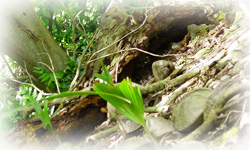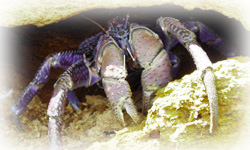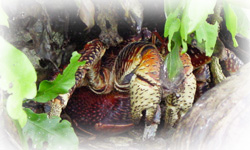Coconut
piles provide food for young crabs as well as
protection. Larger coconut crabs use burrows
under tree roots and logs for a home instead of
carrying around a shell like other hermit crabs.
Burrows help to protect these animals from
dehydration because a burrow is more moist and
cooler than the surrounding environment. Coconut
crabs usually remain hiding in their burrow or
under foliage during the day and come out at
night to find food or a better home.
|

|
|

|
Studies
suggest that the larger crabs remain close to
their burrows because they are already
positioned in the best areas, where as small
crabs will venture across an island in search of
food or a better place to hide. As these animals
grow in size, they depart from the safety of
their existing burrow to find a larger place to
live. Since coconut crabs are not depedent on
snail shells for a home as the progress into
adulthood, they are capable of growing to
extremely large sizes.
|
Coconut
crabs are the largest terrestrial arthropods
currently living on earth. Therefore, it is not
surprising that the largest crabs, which are
also the most dominant, live in the nicest
burrows. Ideal burowing areas are those found in
sandy soil because it is easier for a crab to
dig. That is why smaller crabs often live closer
to the coral edges of the island, where it is
more difficult to build a nice burrow.
|

|
|
|
|

|
The
juvenile coconut crab diet differs from that of
the adults, partly because of where they reside.
The juveniles generally live under coconut piles
or dense vegetation which provide the leaf and
plant litter that they feed on. The adult
coconut crabs are omnivores. They forage by
night for fruits, rotting leaves, coconuts, and
dead or injured animals, as well as other
coconut crabs.
|
|

